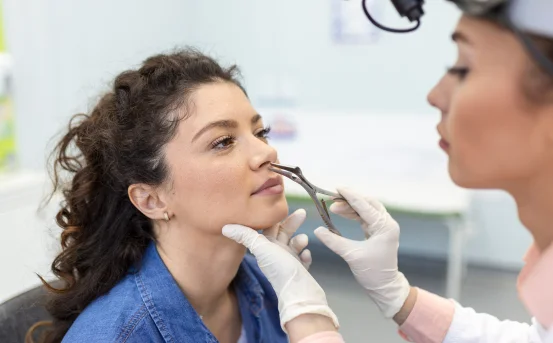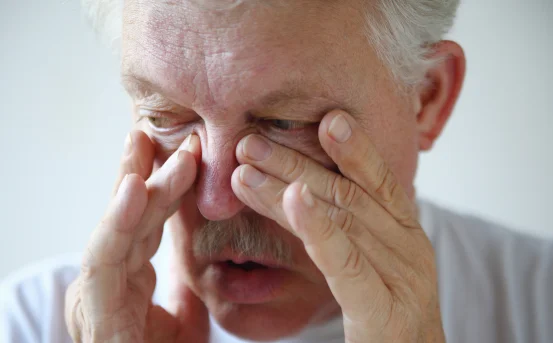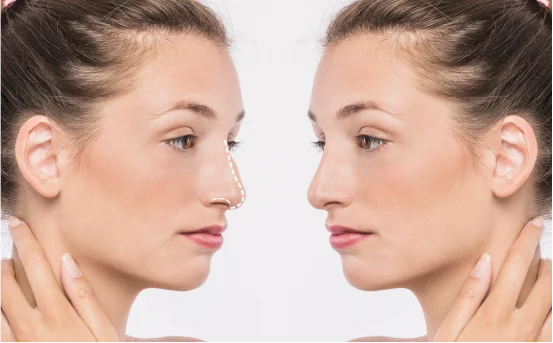Introduction
Rhinoplasty, commonly known as a “nose job,” is a surgical procedure that reshapes or corrects the nose for functional or aesthetic purposes. While many associate rhinoplasty with cosmetic improvements, such as refining the nasal bridge or reshaping the nostrils, the procedure is often also recommended for medical reasons. Recognizing the symptoms or signs that might indicate a need for rhinoplasty can help individuals take timely action toward treatment.
Some people are born with nasal deformities or structural issues that impair breathing, while others may develop symptoms due to injuries, infections, or aging. These symptoms not only affect appearance but can also impact quality of life, sleep, exercise, and self-confidence. Knowing when these symptoms are significant enough to consider rhinoplasty is essential for making an informed health decision. Below are common symptoms for rhinoplasty surgery that you might need to know.
Symptoms for Rhinoplasty Surgery
- Chronic Nasal Congestion or Obstruction :- One of the most frequent medical reasons for undergoing rhinoplasty is persistent nasal blockage. When the structure of the nose interferes with the normal flow of air, it can result in chronic congestion, making it hard to breathe through the nose. This can be caused by a deviated nasal septum, enlarged turbinates, or collapsed nasal valves. Such anatomical issues may not respond well to medications like decongestants or nasal sprays. In these cases, functional rhinoplasty can help open the nasal airways and improve breathing by correcting the underlying structure.
- Frequent Nosebleeds :- If you experience frequent, unexplained nosebleeds, it may be related to structural abnormalities within the nose. Deviated septums or internal irregularities can dry out or irritate the nasal lining, increasing the risk of bleeding. Chronic nosebleeds can disrupt daily life and may be a symptom that the internal nasal structures are not aligned properly. Through rhinoplasty, the nasal pathways can be straightened or widened to reduce irritation and bleeding episodes.
- Difficulty Sleeping or Snoring :- Breathing problems during sleep are often linked to the structure of the nose. If you snore loudly, wake up frequently during the night, or suffer from sleep apnea, it could be due to a nasal obstruction. When nasal breathing is compromised, people often resort to mouth breathing while sleeping, which dries the throat and worsens snoring. Functional rhinoplasty can help eliminate these breathing obstacles, promoting better sleep and overall health.
- Nasal Trauma or Injury :- Accidents, sports injuries, or physical trauma can cause the nose to become misshapen or structurally damaged. In some cases, the trauma is obvious, with visible deformities or swelling. Other times, the symptoms develop later, such as breathing difficulty or discomfort. Post-traumatic rhinoplasty addresses both aesthetic and functional concerns. It helps realign the nasal bones and cartilage, restoring both appearance and airflow. Ignoring nasal trauma can lead to chronic pain or progressive nasal collapse, which might require more complex surgery later.
- Breathing Through One Nostril :- If you find yourself consistently breathing more through one nostril, it may indicate an internal blockage. While this might be tolerable during normal activity, it can become problematic during exercise, sleep, or illness. This asymmetry in nasal airflow is often due to a deviated septum or other anatomical imbalance. Rhinoplasty can help by correcting the deviation, ensuring balanced airflow through both nostrils and improving respiratory efficiency.
- Recurrent Sinus Infections :- Chronic sinus infections may sometimes be related to a poorly structured nasal passage that prevents adequate drainage. This can trap mucus and bacteria, leading to repeated inflammation and infection. Symptoms such as facial pressure, headaches, postnasal drip, and nasal congestion may persist despite medical treatments. In such cases, surgical correction of the nasal structure via rhinoplasty may be recommended to reduce infection frequency and severity.
- Unhappiness with Nasal Appearance :- Many people pursue rhinoplasty for cosmetic reasons due to dissatisfaction with the shape, size, or proportions of their nose. This may include a dorsal hump, a bulbous tip, wide nostrils, or overall imbalance with the rest of the face. Such dissatisfaction can lead to low self-esteem, social anxiety, or avoidance of photos and mirrors. Aesthetic rhinoplasty helps reshape the nose in harmony with facial features, greatly enhancing self-confidence and satisfaction.
- Nasal Asymmetry :- Sometimes, individuals are born with a crooked nose or develop asymmetry over time. A nose that is visibly off-center can make a person feel self-conscious and may also indicate an underlying septal deviation. Corrective rhinoplasty realigns the nose, improving facial balance and symmetry. This is particularly important when the asymmetry also contributes to breathing difficulties or nasal discomfort.
- Impaired Sense of Smell :- A diminished or absent sense of smell (anosmia) can sometimes be due to internal nasal obstructions, especially if accompanied by chronic sinus issues or nasal inflammation. When medication does not resolve the issue, surgical intervention may be necessary. By opening the nasal passages and correcting any physical blockage, rhinoplasty can help restore olfactory function, enhancing both smell and taste sensitivity.
- Changes After Aging :- As people age, the nasal structure can weaken or droop, sometimes narrowing the nasal airway. Some elderly individuals may develop breathing problems, snoring, or cosmetic changes like a hooked or drooping nasal tip. Rhinoplasty can rejuvenate the nasal structure, improving both function and appearance in aging individuals. It supports weakened cartilage, opens up collapsed nasal valves, and redefines a more youthful contour of the nose.
Conclusion
Rhinoplasty is not just a cosmetic procedure it is also a medically important solution for many functional nasal symptoms. Whether you’re dealing with chronic breathing difficulties, frequent infections, sleep issues, or trauma-related changes, the signs pointing toward rhinoplasty should not be ignored.
Early recognition of these symptoms allows for timely surgical intervention, potentially improving both nasal function and appearance. Consulting with a qualified ENT specialist or plastic surgeon can help determine whether rhinoplasty is the appropriate path forward. With advancements in modern surgical techniques, rhinoplasty today is safer, more effective, and more customized than ever before.
If you’re experiencing any of the symptoms listed above and have not found relief through non-surgical treatments, it may be time to explore the benefits of rhinoplasty.























